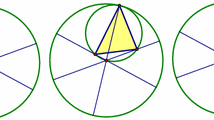Abstract
We consider the problem of moving a line segment (a “rod” or “ladder”) in the plane between two given placements when subject to the constraint that no point on the line segment may exceed a given velocity bound. Specifically, we consider those trajectories which minimize the total time between given initial and goal placements, and provide a complete characterization of all solution, together with explicit constructions for each of the various cases encountered.
Access this article
We’re sorry, something doesn't seem to be working properly.
Please try refreshing the page. If that doesn't work, please contact support so we can address the problem.
Similar content being viewed by others
References
N.I. Akhiezer,Elements of the Theory of Elliptic Funtions, American Mathematical Society, Providence, RI, 1990.
J.-D. Boissonnat and X-N. Bui, Accessibility region for a car that only moves forwards along optimal paths, Research Report 2181, INRIA, BP93, 06902 Sophia-Antipolis, France, 1994.
J. Canny, ISSR.
J. Canny, B. Donald, J. Reif, and P. Xavier, On the complexity of kinodynamic planning,Proceedings of the 29th Annual IEEE Symposium on Foundations of Computer Science, White Plains, NY, October 1988, pp. 306–316.
J. Canny, A. Rege, and J. Reif, An exact algorithm for kinodynamic planning in the plane,Discrete & Computational Geometry,6 (1991), 461–484.
J. Canny and J. Reif, New lower bound techniques for robot motion planning problems,Proceedings of the 28th Annual IEEE Symposium on Foundations of Computer Science, Washington, DC, 1987, pp. 49–60.
Y.B. Chen and D. Ierardi, Optimal motion planning for a rod in the plane subject to velocity constraints, Technical Report USC-CS-92-529, Computer Science Department, University of Southern California, November 1992.
Y.B. Chen and D. Ierardi, Optimal motion planning for a rod in the plane subject to velocity constraints (Extended abstract),Proceedings of the 9th ACM Symposium on Computational Geometry, San Diego, CA, May 1993, pp. 143–152.
Y.B. Chen and D. Ierardi, Optimal motion planning for a triangle in the plane subject to velocity constraints, Technical Report USC-CS-94-570, Computer Science Department, University of Southern California, March 1994.
B. Donald and P. Xavier, Provably good approximation algorithms for optimal kinodynamic planning for cartesian robots and open chain manipulators,Proceedings of the 6th ACM Symposium on Computational Geometry, 1990, pp. 290–300.
V.A. Dubovitskij, The Ulam problem of optimal motion of line segments,Optimization Software, NY, 1985.
M. Goldberg, The minimum path and the minium motion of a moved line segment,National Mathematics Magazine,46 (1973), 31–34.
S.K. Ghosh and D.M. Mount, An output sensitive algorithm for computing visibility graphs,Proceedings of the 28th Annual IEEE Symposium on Foundations of Computer Science, Los Angeles, CA, October 1987, pp. 11–19.
A.B. Gurevich, The most “economical” displacement of a segement,Differential Equations,11 (1975), 1583–1589.
H. Hancock,Elliptic Integrals, Dover, New York, 1917.
M.R. Hestenes,Calculus of Variations and Optimal Control Theory, Wiley, New York, 1966.
C. Icking, G. Rote, E. Welzl, and C. Yap, Shortest paths for line segments,Algorithmica,10 (1993), 182–200.
J.C. Latombe,Robot Motion Planning, Kluwer, Dordrecht, 1991.
D. Leven and M. Shair, An efficient and simple motion planning algorithm for a ladder moving in two-dimensional space amidst polygonal barriers,Proceedings of the 1st ACM Symposium on Computational Geometry, 1985, pp. 211–227.
T. Lozano-Pérez and M. Wesley, An algorithm for planning collision-free paths among polyhedral obstacles,Communications of the ACM,22 (1979), 560–570.
C. Ó'Dúnlaing, Motion planning with inertial constraints,Algorithmica,2 (1987), 431–475.
F.P. Preparata and M.I. Shamos,Computational Geometry, Chapter 7, Springer-Verlag, New York, 1985.
J. Reif and S. Tate, Approximate kinodynamic planning usingL 2-norm dynamic bounds, Technical Report CS-1990-13, Department of Computer Science, Duke University, 1990.
D.B. Reister and F.G. Pin, Time-optimal trajectories for mobile robots with two independently driven wheels,International Journal of Robotics Research,13 (1994), 38–54.
J.T. Schwartz and M. Sharir, On the piano movers' problem: I. The case of a two-dimensional rigid polygonal body moving amidst polygonal barriers,Communications on Pure and Applied Mathematics,36 (1983), 345–398.
J.T. Schwartz and M. Sharir, A survey of motion planning and related geometric algorithms,Artificial Intelligence 37 (1988), 157–169.
S.M. Ulam,A Collection of Mathematical Problems, Chapter VI, Section, 9, Interscience, New York, 1960.
Author information
Authors and Affiliations
Additional information
Communicated by B. Chazelle.
This research was supported by the National Science Foundation under Grant CCR-9207422, and by a grant from the James H. Zumberge Research Innovation Fund. This problem was initially posed in an open problem session of the Second DIMACS Workshop in Computational Geometry, held at Princeton University in October, 1989. A preliminary version of this paper was presented at the 9th Annual ACM Symposium on Computational Geometry [8].
Rights and permissions
About this article
Cite this article
Chen, YB., Ierardi, D. Time-optimal trajectories of a rod in the plane subject to velocity constraints. Algorithmica 18, 165–197 (1997). https://doi.org/10.1007/BF02526032
Received:
Revised:
Issue Date:
DOI: https://doi.org/10.1007/BF02526032




